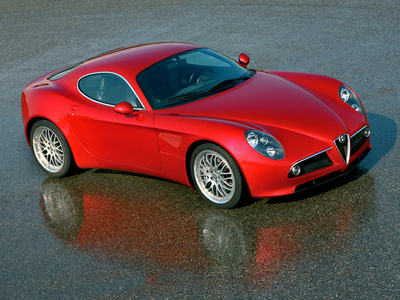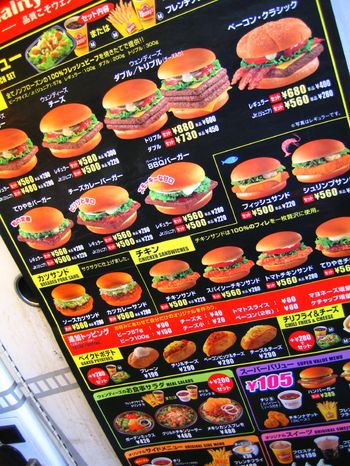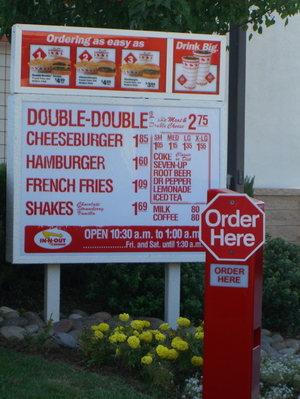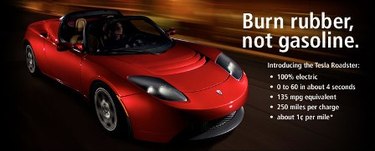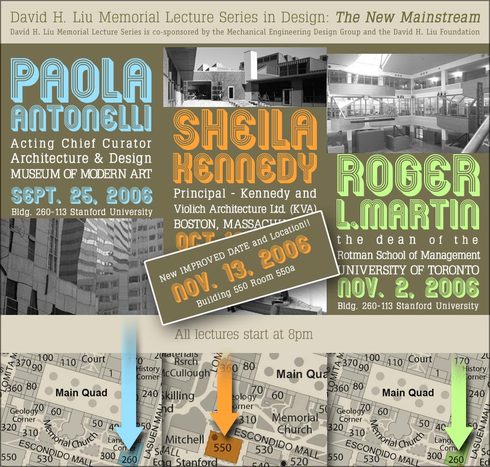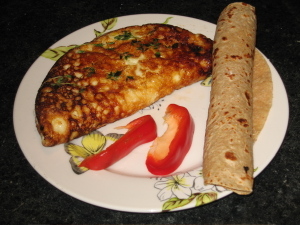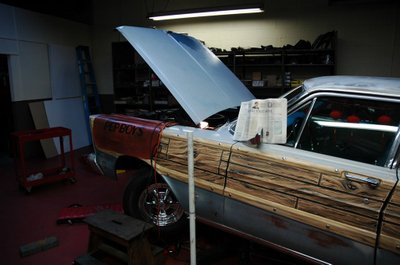Author Archives: Diego Rodriguez
More about simple menus…
I’ve received a few emails challenging my assertion that the In-N-Out menu is simple. Yes, I agree that the top bank of pre-designed meals on the In-N-Out drive thru menu makes the it a less than perfect example of simplicity at work. On the other hand, I find conversations about absolutes to be philosophical minefields… I’d rather make a relative comparison and proceed with thinking about how to do more things that are more good and less bad.
When it comes to menus, more bad (and less simplicity) would certainly look something like this:
photo credit: foomtsuruhashi
A simple menu says so much
A great benefit of reading a book on simplicity is the secret thrill one receives by finding examples of simplicity at work in the course of daily living. Including the drive-thru at In-N-Out Burger.
Here’s a simple drive-thru menu snapped from the window of my car. Lots of Maeda’s Laws at work here. What makes it simple? Some random thoughts:
- An elemental bill of materials. Want fried stuff? French fries. No onion rings. No curly, corkscrew, or chipped potatoes. No fried zucchini or wheatgrass. Simple.
- Popular nouns, rather than branded nouns. A cheeseburger is a cheeseburger is a cheeseburger, not a Whopper or a Bacon Western Cheese.
- Easy to read. For the most part, a big, painted font.
- Simple through time. A consequence (or a driver?) of the previous item. Since the stuff is painted on, it’s likely to be the same selection at the same price the next time I go. Knowing that I can expect the thing I like to be there at the price I expect makes it a simpler transaction experience. This is Law 4 at work.
Reading about Simplicity
I hadn’t read a book in a single sitting since a long night in March, 1995, when I read Ondaatje’s The English Patient after taking The Chunnel from Paris to London. Just as a movie is more satisfying when consumed as a flow experience, a good book begs to be consumed in whole. Last week I had the rare pleasure of spending an evening having just this type of superlative book experience in the form of John Maeda’s The Laws of Simplicity. I devoured it. I’m already using its lessons in my daily work. And I look forward to reading it again soon — I think it’s the most important book I’ve read since Don Norman’s Emotional Design.
In this tidy book of just 100 pages, John Maeda walks us through 10 Laws of Simplicity. This being 2006, I don’t need to list them because you’re better off reading them on his Laws of Simplicty blog (be sure to click on the laws listed down the right column of the page). I’m particularly enamored of Law 10: The One, which is stated as such:
Simplicity is about subtracting the obvious, and adding the meaningful
Adding the meaningful. Think about that. When we strip out the obvious, we edge closer to root nuggets where real value resides. Meaning is what we seek, what leads to happiness. The obvious is banal because it is obvious; there’s no challenge or satisfaction in its consumption. And I believe this state of simplicity is what gives us "universal" offerings and brands such as the iPod, the Citroen 2CV, the Golden Gate Bridge, Muji — each embody Roger Ebert’s sage observation that "The more specific a film is, the more universal, because the more it understands individual characters, the more it applies to everyone." Unique designs appeal to so many of us exactly because they don’t try to appeal to all of us. We want the elegant simplicity of rich meaning.
Thursday Tesla To Do
This coming Thursday, September 14, IDEO will be hosting the good people of Tesla Motors as part of the ongoing IDEO Know How lecture series. The lecture is open to the public. This should be a good chance to drink from the cup of (electric) gearhead gnarlyness.
The lecture will take place at 715 Alma St in Palo Alto at 5pm PST. Enter via the alley off of Forest Avenue between Alma and High streets There won’t be a public videotape available afterward.
Here are some selected quotes from Tesla’s website:
Tesla Motors designs and sells high-performance, highly efficient electric sports cars — with no compromises. Tesla Motors cars combine style, acceleration, and handling with advanced technologies that make them among the quickest and the most energy-efficient cars on the road.
“Our goal in designing the Tesla Roadster was to build a car with zero emissions that people would love to drive,” said Tesla Motors co-founder and CEO Martin Eberhard.
The real difference lies in the intent of the designers. For the most part, electric cars have been designed by people who believed we should not drive, and, if we must, then we should drive a bare-bones electric car. In sharp contrast, the Tesla Roadster is a driver‘s car: optimized for performance and handling, beautiful in every detail. Tesla Motors celebrates driving.
It‘s a no-compromise driver‘s car that can accelerate faster than a Porsche 911 and hit a top speed of nearly twice what the law permits. With a range of 250 miles on a single charge, you can use it all day long and not worry you‘ll run out of juice.
Response to the Tesla Roadster has been even greater than we anticipated, and we’ve “sold out” of our special edition Signature One Hundred Roadsters. We’re now taking reservations for our next 100 Tesla Roadsters to be built.
I, for one, am looking forward to the day when I get to lay a big, fat patch of electric torque-tortured tire rubber.
Update 14sept06: Tesla has a nifty blog worth checking out
David H. Liu Memorial Lecture Series in Design: The New Mainstream
The Stanford Product Design program continues the David H. Liu Memorial Lecture Series in Design with this stunning lineup of speakers:
- Paola Antonelli, MOMA: Sept 25
- Roger Martin, Rotman School of Management: November 2
- Sheila Kennedy, KVA: November 13
Be sure to check the series website for time and location info.
Inspiration in egg whites
I normally shy away from pointing to stuff on other blogs on a routine basis, as I figure you’ll find the good stuff anyway, and I have a bias toward creating original (or as original as anything can be in this connected world) material.
But I’ve had some big milestones with my special project lately. This week we shipped two new material intake devices. And we had a successful alpha launch of our upright ambulation initiative. As with any innovation activities, these required lots of late night effort and were the source of some high drama and tears. Par for the course when it comes to innovation!
So I’m mostly pointing. There’s so much cool stuff out there!
Today Seth uses egg whites and wheat and peppers to write an ode to the gods of authenticity, quality, and doing stuff to the hilt. It’s a reminder to me that delivering great human experiences (even a humble breakfast) is much more a matter of judgment than of rules.
Scuderia Ferrari and the OR
Bruno Giussani, my fellow TED blogger and BusinessWeekOnline contributor, wrote a cool post about how innovation can come from "… an unexpected juxtaposition of seemingly unrelated ideas or concepts…", in this case the Scuderia Ferrari helping a hospital in England with process dynamics:
Pit-stop for doctors
More Contagious Behavior Marketing
Alice LaPlante of InformationWeek wrote this nifty article which goes deeper on some of the ideas which came up in our Contagious Behavior panel discussion at the AlwaysOn conference: Tracking Down "Infectious Agents"
metacool Thought of the Day
"People are not born craftsmen; they just have the courage to screw
things up. Embrace your inner amateur and try everything.
There will always be an expert to take your money and fix the mistakes."
– Mr. Jalopy
And, as we’re fond of saying around the offices of metacool, "Why not do something NOW?" If half of life is about just showing up, then the other half (and more than half when you’re in the business of getting something good done) is about getting past the excuses, grabbing a wrench, and hacking away. Fail early, fail often. Build a prototype. Think global, drink local. Catch something on fire. Why not screw something up today instead of strategizing for the next month? You might learn something. No — you WILL learn something. What’s the worst that could happen?
(note that I use the word "wrench" as a metaphor for whatever it is that you need to do the thing you do)
I love that: "Embrace your inner amateur and try everything." Sounds like design thinking to me.

